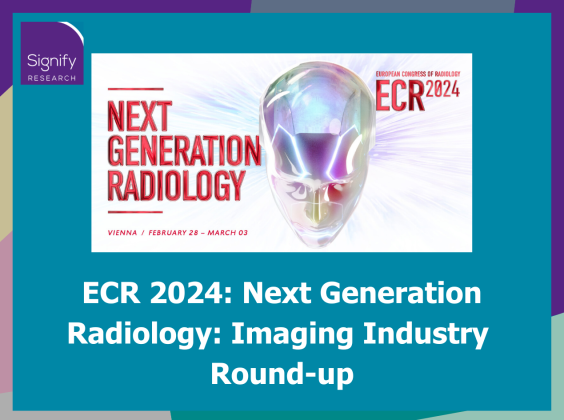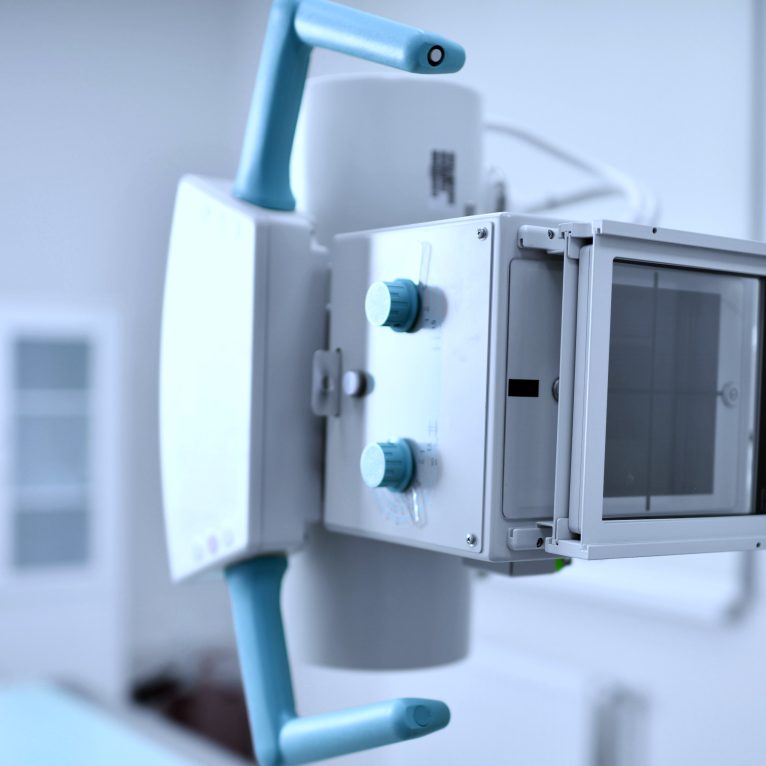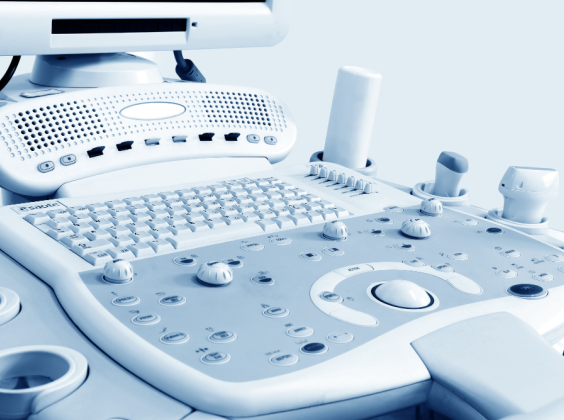
Written by

Cranfield, UK, 13th March 2024, ECR 2024 illuminated the horizon of medical imaging, unveiling a seamless fusion of product breakthroughs and refined techniques that herald a new era in radiology. The overarching theme of this year’s European Congress of Radiology encapsulated the dynamic evolution of the medical imaging landscape to capture the latest pioneering advancements.
Marking a significant rebound since the pandemic, this year’s event witnessed robust attendance, nearing 19,000 participants. Against this backdrop, exhibitors seized the opportunity to spotlight their state-of-the-art solutions, demonstrating how technological innovation can redefine precision medicine and usher in enhanced clinical outcomes. Key topics focused on the delivery of more robust screening, early detection, diagnosis and treatment.
Below, we outline some of the leading themes at the show identified within each core modality seen by our analyst team.
X-ray in focus – Poornima Anil
In X-ray technology, ECR 2024 highlighted the pivotal emphasis of user-friendliness, striving to enhance care accessibility, streamline interventional procedures, and ultimately elevate patient outcomes. The overarching theme underscored the significance of ergonomics, notably showcased through the presentation of advanced features in X-ray equipment. This included the introduction of motorised and automated surgical C-arms, designed not only to optimise the radiologist’s experience but also potentially reduce procedural times.
Interventional radiology advancements were strategically tailored to diminish procedure times, particularly in stroke management, ultimately fostering improved patient outcomes. In the domain of breast imaging, a focus on patient comfort materialised through the introduction of new mammography systems featuring shorter scan times, wider angles, enhanced image quality, and reduced radiation exposure. Complementary software upgrades further enriched diagnostics, offering a more comprehensive approach to care.
The conference also unveiled findings from the MASAI trial, highlighting the profound impact of Artificial Intelligence (AI) in breast cancer screening. This showcased AI’s potential to reduce healthcare professional workloads while delivering superior results. Moreover, AI innovation demonstrated its prowess in addressing operational challenges within X-ray workflows, tackling bottlenecks, enhancing image quality consistency, and optimising protocols. Notably, AI has proven instrumental in elevating image quality for more precise diagnoses and ensuring the safety of X-rays through dose reduction, all without compromising clarity.
The commitment to user-friendliness extended beyond equipment, with discussions centered on seamless and remote service options. This paradigm shift highlights vendors evolving from mere equipment providers to comprehensive support facilitators. The innovation within the X-ray portfolio was driven by a steadfast dedication to enhancing both patient and physician experiences, manifesting in advancements on both the hardware and software fronts.
The exhibition showcased advanced technologies such as Philips’ Zenition 90 and Siemens Healthineers’ self-driving ciartic move 3D C-arm, both incorporating motorized options to enhance user-friendliness and potentially elevate workflow efficiency in operating rooms. Canon Medical introduced AI-powered RT tables, the Xarion, and αEvolve imaging, utilising deep learning-based noise reduction and multi-frequency processing for interventional X-ray. This trend was exemplified by Fujifilm’s Amulet Sophinity digital mammography system and Siemens Healthineers’ MAMMOMAT B.brilliant system. Melatronica contributed to this focus with its Ibex software, offering additional wrist bone density measurement options in a mammogram system. In neuroradiology, Philips unveiled the Azurion neuro biplane system, capturing 3D views with images from two X-ray detectors and featuring automatic vascular outlining. Anticipated benefits include streamlined workflows, improved treatment precision, and potentially faster and better patient outcomes.
Molecular Imaging elevating precision medicine – Sean Bradley
Molecular Imaging, a dynamic frontier in Medical Imaging, addresses heightened healthcare demands for early, non-invasive diagnosis. As demand increases across the healthcare industry for earlier, more timely diagnosis, non-invasive treatment and diagnosis techniques, Molecular Imaging continues to demonstrate its future in precision medicine. The key trends in molecular Imaging were centred around industry-leading temporal resolutions, reducing patient radiation exposure, operational efficiencies and ease-of-use for technicians and practitioners. However, Molecular Imaging vendors still require a primary focus on scientific research to validate clinical applications and use cases. There were notable announcements from leading medical imaging vendors, which debuted the latest state-of-the-art innovation in Molecular Imaging and full-body PET Imaging. Challenges in European regulatory approval provided a notorious hurdle for global companies entering the market, which can cause delays in availability. Demonstrations and applications of how artificial intelligence can enhance and streamline procedures were also prominent, with the role of theranostics in comprehensive cancer a focus.
United Imaging showcased its uExcel multi-dimensional technology platform, emphasising functionality, ease of use, safety, and scientific research. Concurrently, it introduced the uMI Panorama GS, aiming to set the standard for molecular and full-body PET imaging. Siemens Healthineers secured FDA approval for the Biograph Vision.X, a PET/CT scanner heralded as a significant advancement in their Biograph Vision line. With an industry-best temporal resolution of 178 ps, it represents a 20% performance boost, enhancing patient throughput and reducing radiation exposure. GE HealthCare unveiled the all-digital Omni Legend platform, focusing on substantial improvements in the scanning process, emphasising operational efficiency and patient comfort. This trend aligned with workflow optimisation and incorporated artificial intelligence to elevate and expedite the overall scanning experience.
Next-generation Ultrasound offering more affordable solutions – Mustafa Hassan
At ECR 2024, ultrasound vendors honed in on critical themes: alleviating heavy workloads and addressing budget constraints in the challenging economic landscape. While staff shortages pose limitations, ultrasound vendors showcased AI solutions as a key strategy to optimise workflows and enhance scanning efficiency, meeting the urgent needs expressed by customers. Growing trust in decision support tools is shaping the landscape, with vendors poised to deploy these solutions as customer confidence continues to rise.
The economic downturn in Europe has diminished purchasing power, prompting a shift in some regions; price is increasingly prioritised when selecting radiology system vendors, providing an advantage to competitively priced Chinese vendors. To counter this trend and retain customers, established vendors like GE HealthCare and Canon Medical launched cost-effective systems at ECR, such as the LOGIQ Totus and Aplio Me, respectively. Esaote also introduced its budget friendly MyLab A50 and MyLab A70 systems showcased previously at Arab Health. Mindray, traditionally focused on lower-priced segments, showcased premium offerings like the Resona 9 Platinum and Resona I9 Elite at ECR, expanding its portfolio.
A notable highlight at ECR 2024 was the return of SuperSonic Imagine, recently acquired by SSH Holdings following its 2019 acquisition by Hologic. Additionally, DeepSight, which debuted at RSNA 2023, previewed its upcoming technology in Vienna. These developments signal a dynamic landscape as vendors navigate evolving customer needs and market dynamics.
MRI and CT steal the spotlight once again – Bhvita Jani
In recent radiology shows, medical imaging vendors showcased their cutting-edge MRI and CT product lines—a trend that continued to shine at ECR 2024. Despite the unveiling of the latest innovations at RSNA 2023, the enthusiasm of MRI and CT vendors to present state-of-the-art technologies to their European counterparts was notable, particularly with a focus on advancing cancer care and promoting sustainability.
Sustainability once again was a prominent trend, with a growing commitment to decarbonising radiology while fostering early diagnosis and minimising the environmental impact of healthcare systems. Notably, the exhibition featured helium-free or reduced helium MRI systems, including the European premiere of Philips’ helium-free Mobile MRI system, enabling MRI accessibility in new and remote settings. Philips exhibited its MR7700, featuring a fully automated workflow demonstrating a 53% reduction in energy consumption per scan using its Smart Speed technology. Siemens Healthineers also highlighted its most sustainable MRI system, the 1.5T Magnetom Flow, with 0.7l of helium sealed for life.
AI continues to play a pivotal role in simplifying and automating CT and MRI workflows. One application enables contrast-free or reduced-contrast examinations. In the CT market, vendors demonstrated how AI and intelligent automation continue to streamline departmental workflows, integrating virtual imaging tools. Philips promoted its AI-enabled camera workflow in the CT5300 with industry-leading reconstruction, whilst Canon Medical’s Aquilion Serve also demonstrated AI-powered workflow optimisations, including integrated cameras.
From a clinical perspective, Alzheimer’s disease emerged as a prominent theme in the MRI market. Vendors were eager to underscore MRI’s role in ongoing patient management throughout the care pathway. AI’s influence was unmistakable in ensuring swift, automated, and reproducible scans, particularly in automating the visualisation of brain anatomy and abnormalities.
Photon-counting CT has witnessed significant advancements, with over 600,000 patient scans on Siemen’s NAEOTOM Alpha to date, being the subject of 300 published studies. Key clinical applications emerging include cardiac imaging, oncology, and neurology due to the ultra-high resolution. While some vendors with Photon-Counting CT systems in the developmental stage have shared updates on their prototypes and progress, much of this information remains under Non-Disclosure Agreements (NDAs).
Another notable theme involved democratising advanced and premium features, making them accessible throughout the value chain on high-performance and low-end systems. This was particularly apparent by GE HealthCare, which demonstrated how Revolution Ascend CT features could be brought to the Apex edition of their systems. In addition, GE HealthCare debuted its first “ECG-less” cardiac CT designed to enable better workflow for emergency procedures on its Revolution Apex.
Closing statement
In essence, ECR maintained its status as a pivotal platform for unveiling the forefront of cutting-edge technology in Medical Imaging. Although a significant portion of product introductions had already been debuted at RSNA 2023, the event further cements ECR’s ongoing significance as a primary stage for innovation in the field.
It was clear that the focus for Medical Imaging vendors is to address workflow shortages and maintain the quality of scans across the workforce through heightened automation and AI-empowered workflows. Furthermore, there was a concerted effort to broaden the accessibility of high-end features, extending them to more performance-oriented systems. The unwavering commitment to sustainability remained paramount in the most advanced imaging lines. And, in the perpetual pursuit of excellence, the demonstrations highlighted the consistent dedication to achieving enhanced precision in clinical outcomes.
Related Research
Signify Research Market Intelligence Portfolio provides rolling 12-month coverage of the Medical Imaging markets. Our comprehensive analysis covers the X-ray, Ultrasound, MR, CT and Molecular Imaging markets. The reports featured on each core imaging modality provide a data-centric and global outlook of the market. The reports blend primary data collected from in-depth interviews with healthcare professionals and technology vendors to provide a balanced and objective view of the market.
About The Author
About Bhvita Jani
Bhvita joined Signify Research in 2020 as part of the Medical Imaging Team, focusing on the X-ray market. Prior to joining, she brought with her 4 years’ experience covering X-ray, MRI, and CT research at IHS Markit. She received her bachelor’s degree with honors in Biology and Psychology from Aston University.
Signify Research’s Medical Imaging team formulates expert market intelligence for some of the leading Ultrasound, CT, MRI, and X-ray vendors. Combining primary data collection and in-depth discussions with industry stakeholders, our thorough research approach yields credible quantitative and qualitative analysis, helping our customers make critical business decisions with confidence. Furthermore, our commitment to seeking a plurality of perspectives across the markets we cover guarantees that our insights remain independent and balanced.
About Signify Research
Signify Research provides healthtech market intelligence powered by data that you can trust. We blend insights collected from in-depth interviews with technology vendors and healthcare professionals with sales data reported to us by leading vendors to provide a complete and balanced view of the market trends. Our coverage areas are Medical Imaging, Clinical Care, Digital Health, Diagnostic and Lifesciences and Healthcare IT.
Clients worldwide rely on direct access to our expert Analysts for their opinions on the latest market trends and developments. Our market analysis reports and subscriptions provide data-driven insights which business leaders use to guide strategic decisions. We also offer custom research services for clients who need information that can’t be obtained from our off-the-shelf research products or who require market intelligence tailored to their specific needs.
More Information
To find out more:
E: enquiries@signifyresearch.net
T: +44 (0) 1234 986111
www.signifyresearch.net


